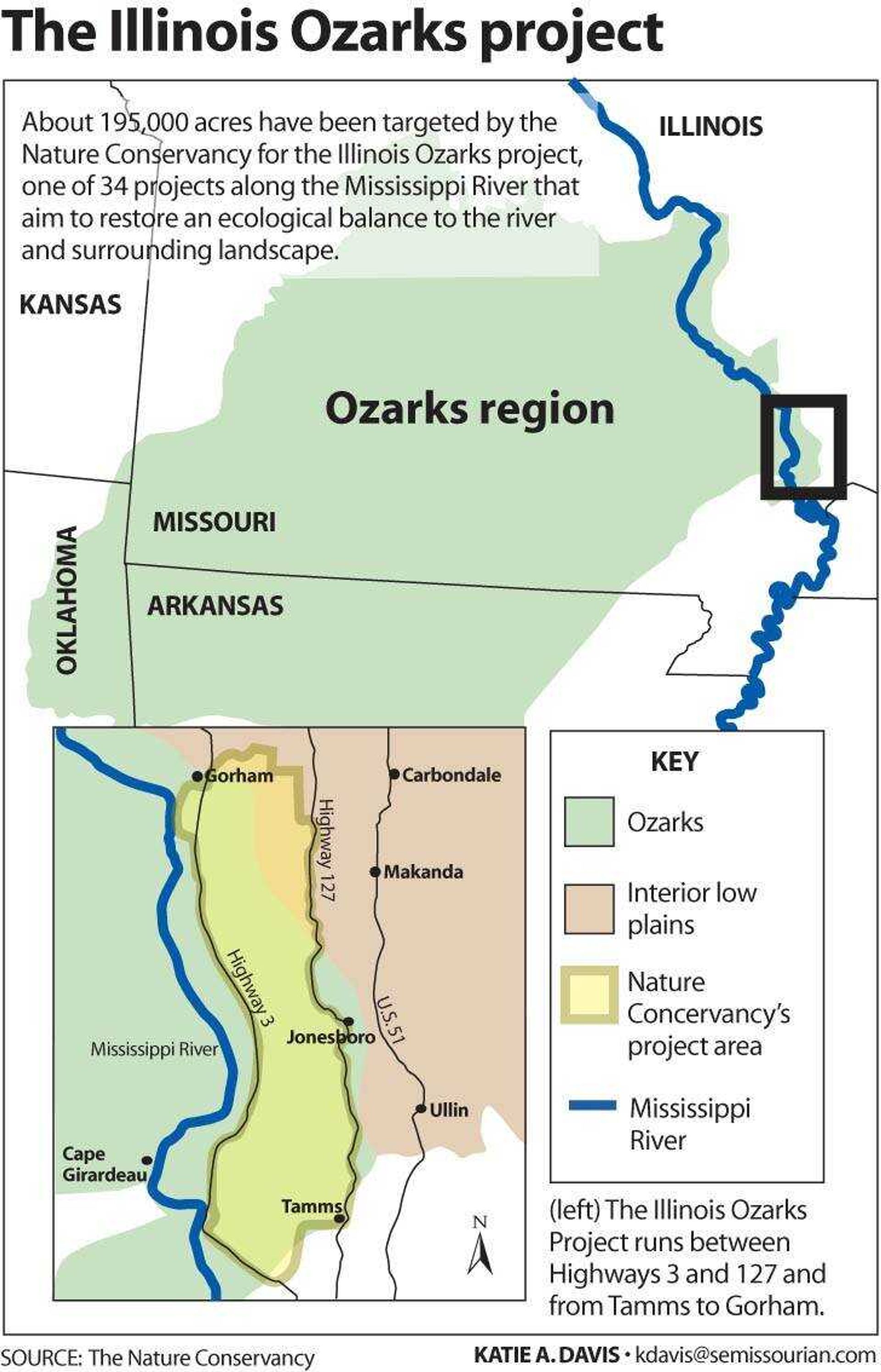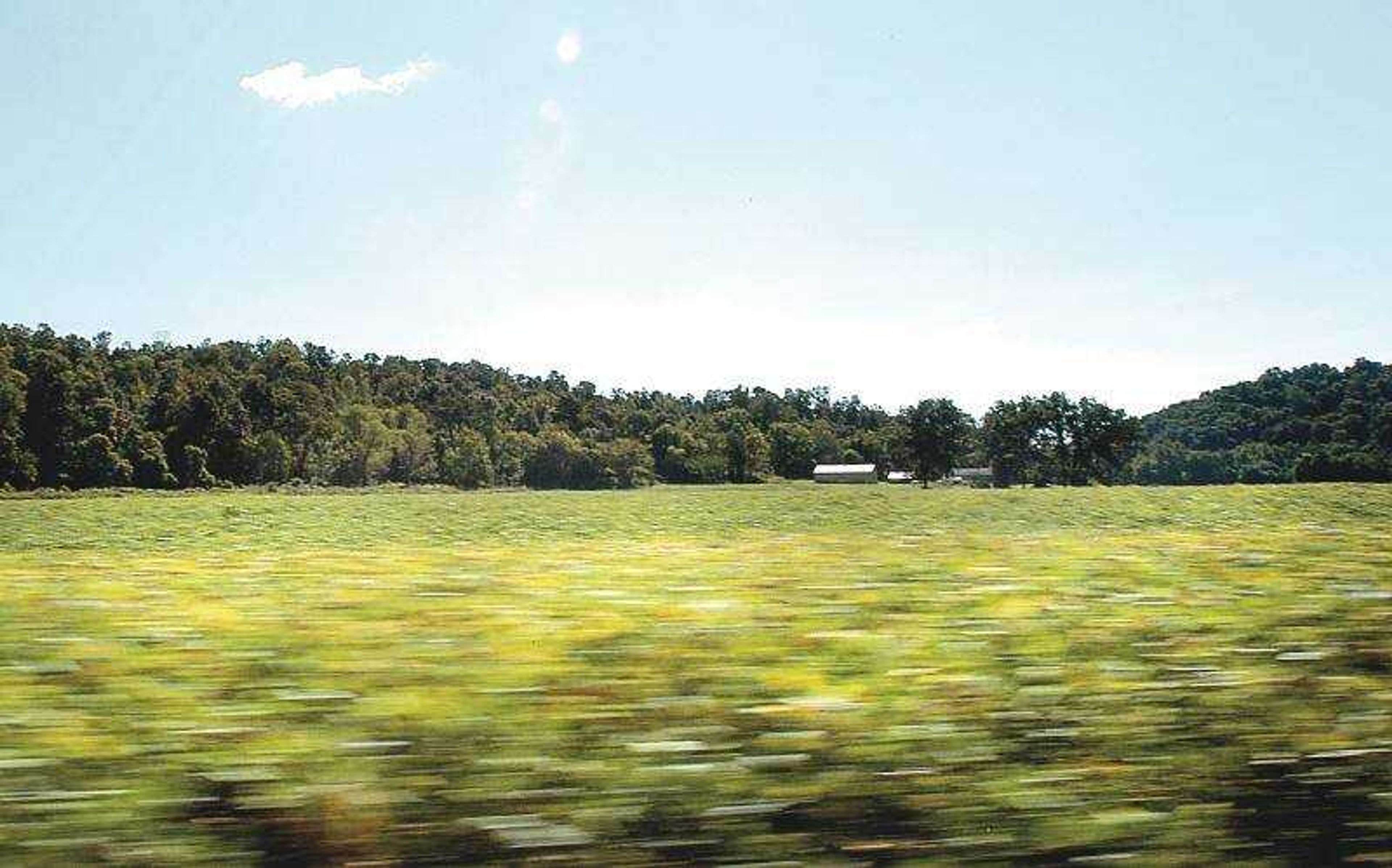Environmental group works with landowners to protect habitat
BALD KNOB, Ill. -- When Michael Baltz gets wound up, few things can interrupt his sweeping descriptions of the Nature Conservancy's vision for Southern Illinois -- few things, that is, except a little bird. Baltz, a University of Missouri-educated biologist, stops in mid-sentence as the "pit-i-tuck" of the summer tanager arrives on the wind...
BALD KNOB, Ill. -- When Michael Baltz gets wound up, few things can interrupt his sweeping descriptions of the Nature Conservancy's vision for Southern Illinois -- few things, that is, except a little bird.
Baltz, a University of Missouri-educated biologist, stops in mid-sentence as the "pit-i-tuck" of the summer tanager arrives on the wind.
The tanager, which weighs a little more than an ounce, travels more than 1,000 miles to winter every year in Central and South America. The tropical songbird isn't endangered, but many of its cousins in the Illinois Ozarks are, and Baltz has taken on the job of helping to save them.
"Forest-nesting birds are kind of sexy," Baltz said as he described how the landscape around Bald Knob, the third highest point in Illinois, could be improved. "They are colorful and give us ties to exotic places like Central America. Not only are they sexy and pretty, but they are world travelers and many weigh less than 10 grams."
The Bald Knob and Clear Creek wilderness areas in Union County are the heart of the Illinois Ozarks, the easternmost outcropping of the five-state Ozarks region. The Ozarks, which date back nearly 1.5 billion years, is the only significant highlands in the United States between the Appalachian chain and the Rocky Mountains.
The Nature Conservancy, a not-for-profit environmental group dedicated to preserving unique habitats, in the late 1990s began studying the entire Ozarks region to identify high-priority areas and the Illinois Ozarks Project took off a few years later.
The project is one of 34 Nature Conservancy projects along the Mississippi River from Minnesota to the Gulf of Mexico aimed at restoring ecological balance to the river and the surrounding landscape.

The conservancy's project covers 195,000 acres stretching from Thebes, Ill., in the south to Gorham, Ill., in the north. Of that land, approximately 96,000 acres are already publicly owned, either by the National Forest Service or the Illinois Department of Natural Resources.
Most of the area is woodlands, with about 13,000 acres of cropland. More than 1,200 plant and animal species inhabit the Illinois Ozarks, including 65 species of reptiles and amphibians. Of those 1,200 species, 43 of them are listed as endangered or threatened by the state.
The highest priority sites, Baltz said, are the bottomland farms nestled among the forests. Openings that are too large, he said, allow skunks, snakes, raccoons, crows and blue jays, among others, to easily invade areas needed by migratory songbirds and other target species.
"There are a lot of critters who need large tracts of intact forest," Baltz said.
Farming in the Illinois Ozarks is a bigger concern than other Ozark areas, he said, because the soil is generally better cropland than in other parts of the five-state region. The Nature Conservancy doesn't oppose farming and isn't interested in kicking farmers off land, he said.
Instead, the conservancy waits for landowners to make the first move by putting their property on the market. Farmland in the region typically is small plots of 60 to 70 acres surrounded by forest.
"What happens is that a local farmer might be interested in the fields but they won't want the woods," Baltz said. "One of the reasons we have been successful in buying land is that we are willing to buy the whole thing."
The Nature Conservancy tries to be a good neighbor while it owns a piece of property, Baltz said. Since government agencies that will become the eventual owners of the land generally needed 18 months to two years or longer to get approval for land purchases, the conservancy typically allows farmers who rent land to continue planting crops until the public owner steps in.
One site along Hutchins Creek is an example. Nestled between the wilderness areas, the 240-acre tract has about 100 acres of fields, planted in soybeans this year. The conservancy purchased the land last year from an aging couple who wanted to move to Cape Girardeau and had no children interested in continuing the farm.
Along with renting the land for crops, the conservancy hired a local caretaker to keep the five-acre homesite mowed. That helps with public relations, he said. Too often, environmental groups are viewed as antagonistic to landowners.
By easing the land out of production, he said, "even the people who are inclined not to like us view us as more good than bad."
The conservancy has set four priorities for its work in the Illinois Ozarks -- reducing forest fragmentation, promoting upland forests, restoring hill prairies and supporting the endangered Indiana bat.
Prior to settlement, the mature forest was mainly oak and hickory trees. The forests were exploited for timber and cleared for subsistence farming. The Shawnee National Forest was established in the early 1930s to reverse that trend, with much of the original land acquired as a result of abandonment and tax foreclosures.
The forest service vigorously pursued fire suppression, which over time has changed many areas from wildlife-friendly oak and hickory to less productive maple and beech trees.
"What you are looking at is a forest in trouble," Baltz said.
The Nature Conservancy isn't buying land to become a big landowner and stop farming in sensitive areas, Baltz said. The conservancy works in partnership with the forest service and the Illinois Department of Natural Resources, purchasing land quickly and then allowing the government agencies time to request the money needed to bring property into public ownership.
The partnership approach represents a shift in focus by the conservancy as it moves away from purchasing small but significant sites to addressing areas as a coordinated ecosystem, he said.
"We are going to be a whole lot less successful on a much smaller scale than if we work with the forest service and trust them to do the right thing," he said.
In 2004, the forest service began looking at land outside its previous boundaries for opportunities to purchase land, said David Lentz, district ranger at the Mississippi Bluffs Ranger District office in Jonesboro, Ill.
The Department of Interior authorized the purchase of up to 60,000 acres between the western edge of the forest and the Mississippi River, Lentz said.
The Nature Conservancy and other environmental groups that are buying land are key to the success of those purchases, he said.
"Our primary way of doing it is through partnershps," Lentz said. "They are able to acquire land much quicker than we are."
As the Illinois Ozarks Project moves forward, Baltz said, the loss of farm production will be minimal and the benefits for wildlife will be substantial.
And the benefits for the landowners who had difficulty selling land will be substantial as well, he said. The average age of farmers is increasing and economic opportunities continue to draw young people away from the land.
"This is a period of time when people who have been long-time landowners are selling," he said. "And for the first time in history, you can do well selling your land."
rkeller@semissourian.com
335-6611, extension 126
Connect with the Southeast Missourian Newsroom:
For corrections to this story or other insights for the editor, click here. To submit a letter to the editor, click here. To learn about the Southeast Missourian’s AI Policy, click here.











